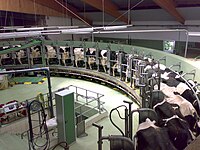
Photo from wikipedia
The floor surface of the cubicle is a detrimental factor on cow comfort. The effects of two floor types, rubber and concrete, on dairy cow comfort and milk production were… Click to show full abstract
The floor surface of the cubicle is a detrimental factor on cow comfort. The effects of two floor types, rubber and concrete, on dairy cow comfort and milk production were compared for a period of 13 weeks. Fourteen Friesian crossbred dairy cows with an average body weight of 425.67 ± 61.12 kg (mean ± SD), nose to tail body length of 2.07 ± 0.15 m, rump height of 1.29 ± 0.02 m, hook bone width of 0.48 ± 0.05 m, and body condition score (BCS) of 4.13 ± 0.44 were used, with seven cows per flooring treatment. The cows produced a mean of 15.93 ± 4.03 l/cow/day and a constant feeding plan was practiced. The swelling and wound severity of hocks diminished (P < 0.05) starting at the third and tenth weeks, respectively. Daily lying time/h (concrete: 9.67 ± 1.24, rubber: 10.60 ± 0.69, P = 0.046) and average duration of lying bouts/min increased (concrete: 58.16 ± 7.74, rubber: 65.66 ± 9.85, P = 0.050) starting from the twelfth week on rubber bedding. Prevalence of mastitis, lameness, and cow cleanliness remained unchanged on floor treatments. A progressive increase in daily milk production/l (concrete: 13.37 ± 1.46, rubber: 16.67 ± 2.24, P = 0.007) of cows in rubber bedding was observed at the fourth week of the experiment. Hence, the current study suggests that the use of softer bedding such as rubber mats could improve cow comfort and daily milk production of cows.
Journal Title: Tropical animal health and production
Year Published: 2021
Link to full text (if available)
Share on Social Media: Sign Up to like & get
recommendations!